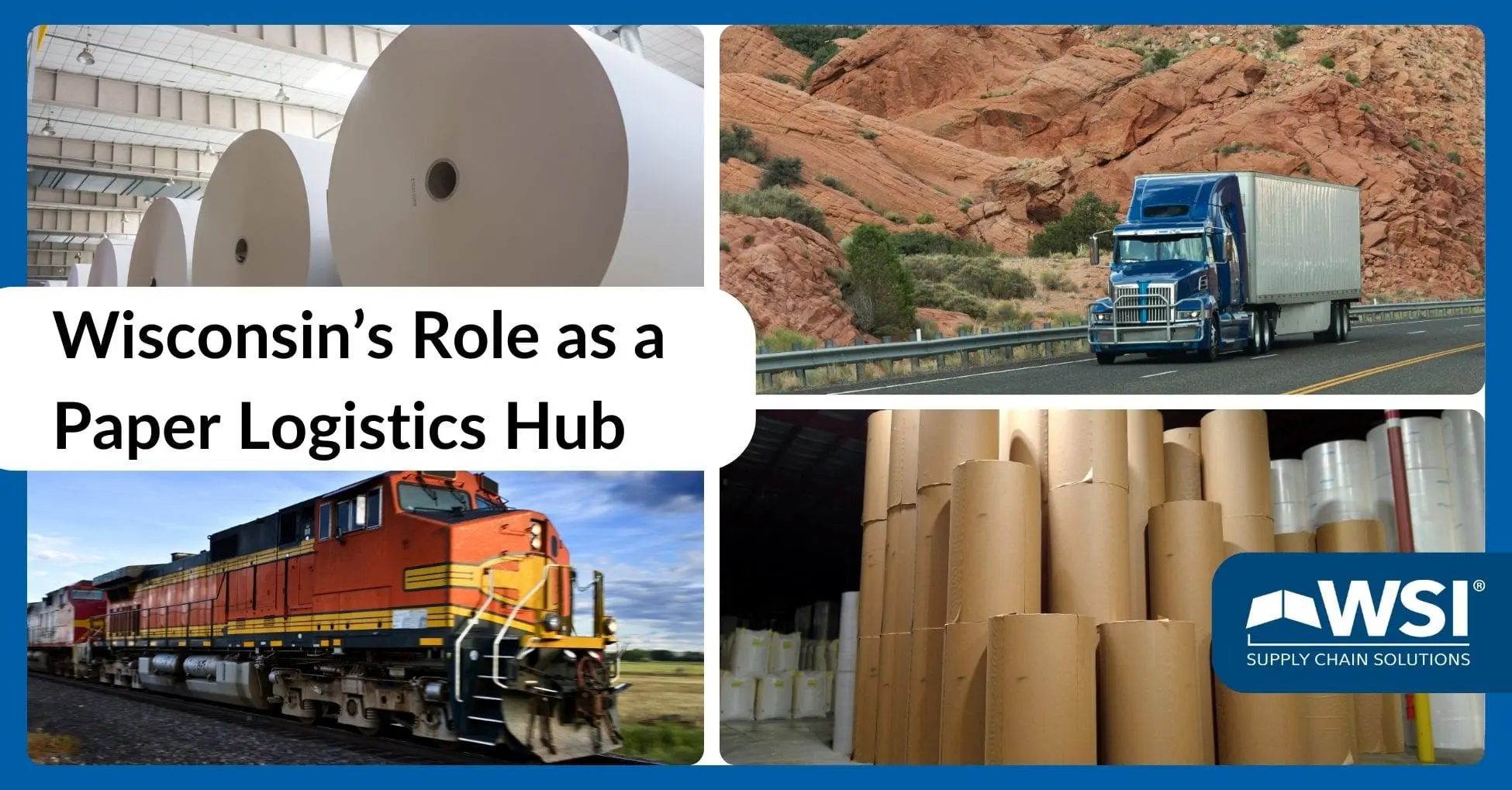Wisconsin’s Role as a Paper Logistics Hub
Did you know the paper and pulp industry is one of the world’s largest industries? The U.S. alone produces more than 70 million tons of paper and board every year, according to the Association of American Railroads (AAR). These products are vital for food safety, security and e-commerce, among many other applications.
With a 175-year heritage, Wisconsin’s paper and forest products industry remains dominant in the U.S. despite turmoil in recent decades. In addition to paper mills and production facilities, the Wisconsin paper industry supports a number of related industries, including converting, printing, and other companies that use paper products for manufacturing and packaging.
Northern and Central Wisconsin have a long history of papermaking. From its start in southeastern Wisconsin in the 1850s, the paper industry quickly moved north to the Fox River Valley in northeastern Wisconsin. The Fox River Valley region, dubbed the Paper Valley, stretches from Green Bay in the northeast to Oshkosh in the southwest part of Wisconsin. Among several cities in the region supporting the paper industry, Neenah is perhaps the best known. In Central Wisconsin, towns like Wisconsin Rapids and Stevens Points are home to multiple paper converting companies.
The Shifting Wisconsin Paper Industry
The Wisconsin paper industry has weathered many changes over the last 30 years, reflective of national industry trends, with a number of shifts and closures of paper mills and other facilities, according to a 2022 study by the University of Wisconsin-Oshkosh’s Center for Customized Research and the Wisconsin Paper Council. Ownership changes and industry consolidation have contributed to moves of headquarters out of state and closures, including a number of Wisconsin-based privately held, family-owned businesses.
In recent years, foreign direct investment in U.S. businesses has increased with several European organizations bringing new ownership of paper businesses and capital into the state. E-commerce has also propelled growth in packaging materials, including corrugated board and paper mailers. Wisconsin is Amazon’s top producer of cardboard box materials, according to the University of Wisconsin-Oshkosh.
While the industry has seen shifts and closures, several communities still thrive as hubs for paper production and processing. Wisconsin still tops the nation in the number of paper mills, employees, and volumes of paper products sold, according to a 2019 report by the Wisconsin Paper Council.
The 2019 Wisconsin Paper Council study also found that 41 of the state’s 72 counties are home to at least one paper manufacturing business, whether a paper mill or a converter business, such as paperboard, printing or packaging converters, among other types of converters. More recently, among the many types of paper and forest product-businesses in the state, about 32 paper mills remained in 2022, according to the Wisconsin Paper Council.
The Wisconsin papermaking industry directly employs more than 30,000 workers, generating over $18 billion in annual sales, according to the 2022 University of Wisconsin and Wisconsin Paper Council study.
As for industry jobs, in 2020, analysis from the Wisconsin Department of Natural Resources noted Brown County (with cities that include Green Bay and Howard) has the state’s highest number of pulp, paper, and forest products industry jobs in the state as well as production volumes. And Winnebago County (with communities that include Oshkosh and Neenah) boasts the highest number of value-added jobs in the pulp and paper industry.
Rail Leads Paper Logistics
Rail, truck, barge or ship are the most common forms of transport for pulp and paper products with rail the most common for hauling large quantities over long distances efficiently.
Rail transportation plays a primary role in the supply chain for paper commodities and products, connecting forests, mills and paper production facilities across the country. In fact, about 700,000 carloads of pulp and paper products are moved by U.S. rails annually, according to the AAR. These include raw materials such as pulp and chemicals, partially finished products like paperboard and wood pellets, and finished products such as newsprint, which is transported in large rolls, office paper and specialty papers, paperboard and corrugated.
What’s transported on rail? Types of shipments include wood chips for pulp production (often transported in open-top railcars), pulp (covered hopper cards or specialized railcars designed for bulk handling), recycled paper in baled form as well as chemicals and additives used in paper production.
The WSI Paper Heritage
WSI has deep roots in the Wisconsin paper business starting with warehousing for local paper mills in 1966 at its first warehouse. The company has since grown its warehouse operations and logistics services to span operations in 10 states. Currently, WSI offers about 8.5 million square feet of warehouse space in Wisconsin across multiple locations.
The company proudly serves the Wisconsin paper industry from a number of rail-served warehouses, conveniently located in close proximity to mills and other producers in several cities across the Paper Valley. As a 3PL partner of record to many paper businesses, WSI customers include corrugated box manufacturing plants, carton board producers of food trays and packaging boxes, linerboard makers, and manufacturers of thermal/carbon paper, among others. The paper supply chains that WSI helps customers manage also extend internationally.
WSI’s key focus in serving paper-industry customers is warehousing at its rail-served facilities, involving the unloading and loading of rail cars. The company also provides transloading and truck brokerage services to these customers in Wisconsin and beyond. This means coordinating truck or railcar shipments of rolls of paper, pulp, cellulose, or cartons, for example, on a daily basis to and from customer facilities. Rail cars especially have to get unloaded promptly to avoid rail demurrage fees.
Mills often place their order for rolls of paper in the morning and need their stock delivered on time to meet afternoon production times. Paper customers can’t have failures as missed shipments can impact production schedules at great expense. Several WSI customers operate 24/7 and as their warehousing partner, WSI promptly responds to emergency calls for stock.
Toward Sustainability and Innovation
The legacy of papermaking continues to shape the economic and cultural landscape of a number of Wisconsin communities. While the Wisconsin paper industry has seen decline in recent decades, the industry has diversified and there are bright spots of growth, such as corrugated and specialty papers.
The Wisconsin paper industry is one in transition. Its future, in part, is dependent on both innovation and sustainability, noted the 2022 study by the University of Wisconsin-Oshkosh and the Wisconsin Paper Council.
The industry has largely moved away from many pollutive practices, and paper is one of many sectors that is recognized for its sustainability. Paper-recycling facilities contribute to the sustainability of the paper industry. Wisconsin leads the country in the production of pre- and post-consumer recycled paper. As for innovation, it must come in the form of new products and investments in new equipment and automation technologies.
The development of improved rail and intermodal infrastructure, though slow in the making given the magnitude of collaboration and capital required, will also support sustainability and innovation.
Conclusion
Wisconsin’s paper industry remains a vital part of the state’s economy and heritage. As the industry continues to evolve, WSI is committed to supporting its growth and sustainability. With our expertise and infrastructure, we are dedicated to helping paper companies thrive in a rapidly changing market. As the industry looks to the future, one thing is clear: Wisconsin will remain a hub for paper production and innovation, and WSI will continue to be a strong ally.
Find out more about WSI’s capabilities by getting in touch with us today.
About the Author

Mikayla Josefchuk
Mikayla Josefchuk is WSI’s Inside Sales and Marketing Representative, providing customers with insights on tailored supply chain solutions including warehousing, transportation, and eCommerce fulfillment. A business school graduate of the University of Missouri – Columbia, Mikayla focuses on business development and content creation. When she’s not at work, Mikayla spends her time on walks with her dog, Boone.





